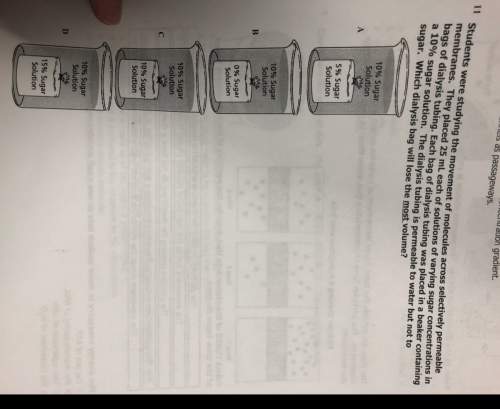
Biology, 28.06.2020 04:01 aatharris21
HELP! NOW! HURRY!
A plant seed is exposed to a chemical mutagen. The embryo undergoes a subsequent mutation that renders its gene for mitochondrial ATP synthase
nonfunctional. If the seed is planted in soil, which of the following is the most likely effect of this mutation on the developing embryo?
A. The plant will not germinate, because its cells will not be able to extract the energy it needs from glucose present in stored starch granules.
B. The plant will germinate and grow normally, because the mutation has no negative effect, since the plant can meet its energy needs by carrying out photosynthesis.
C. The plant will germinate and grow as a sickly plant, because it will use chloroplast ATP synthase in place of the nonfunctional mitochondrial ATP synthase.
O D. The plant will germinate but not grow, because it will not be able to extract the energy it needs from glucose made by photosynthesis in emerging leaves.

Answers: 2
Another question on Biology

Biology, 21.06.2019 19:30
Animal bodies (and even plant bodies for that matter) are complex enough that life couldn't exist without enzymes. enzymes are usually large, complex biological catalysts that are expensive to make. enzymes speed up the rate of chemical reactions without being used up during the reaction (they can be reused many times). they are highly specific in the reactions they regulate. knowing what enzymes are and how they function, why does this explain why complex life forms could not exist if there were no enzymes.
Answers: 1

Biology, 21.06.2019 22:30
How can you approximate the number of calories required to keep you in energy balance?
Answers: 2

Biology, 22.06.2019 00:10
Asap what occurs after cytokinesis is completed at the end of meiosis 1?
Answers: 1

Biology, 22.06.2019 01:00
Put the following processes of protein synthesis in the correct order: - dna strands unwind and separate - mrna copies dna according to complimentary base pairing - trna's anticodons bring amino acids to the corresponding mrna codons - amino acids bind to each other making a protein - mrna leaves the nucleus - a stop codon is reached, the newly formed protein is released to go do its job for the cell
Answers: 1
You know the right answer?
HELP! NOW! HURRY!
A plant seed is exposed to a chemical mutagen. The embryo undergoes a subsequent...
Questions



Social Studies, 10.12.2021 08:50



English, 10.12.2021 08:50

Advanced Placement (AP), 10.12.2021 08:50

Social Studies, 10.12.2021 08:50

Mathematics, 10.12.2021 08:50

Mathematics, 10.12.2021 08:50



Social Studies, 10.12.2021 08:50

English, 10.12.2021 08:50

Mathematics, 10.12.2021 08:50

Chemistry, 10.12.2021 08:50


Chemistry, 10.12.2021 08:50





